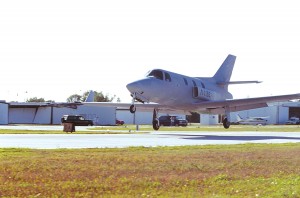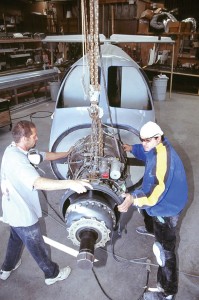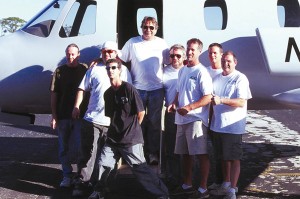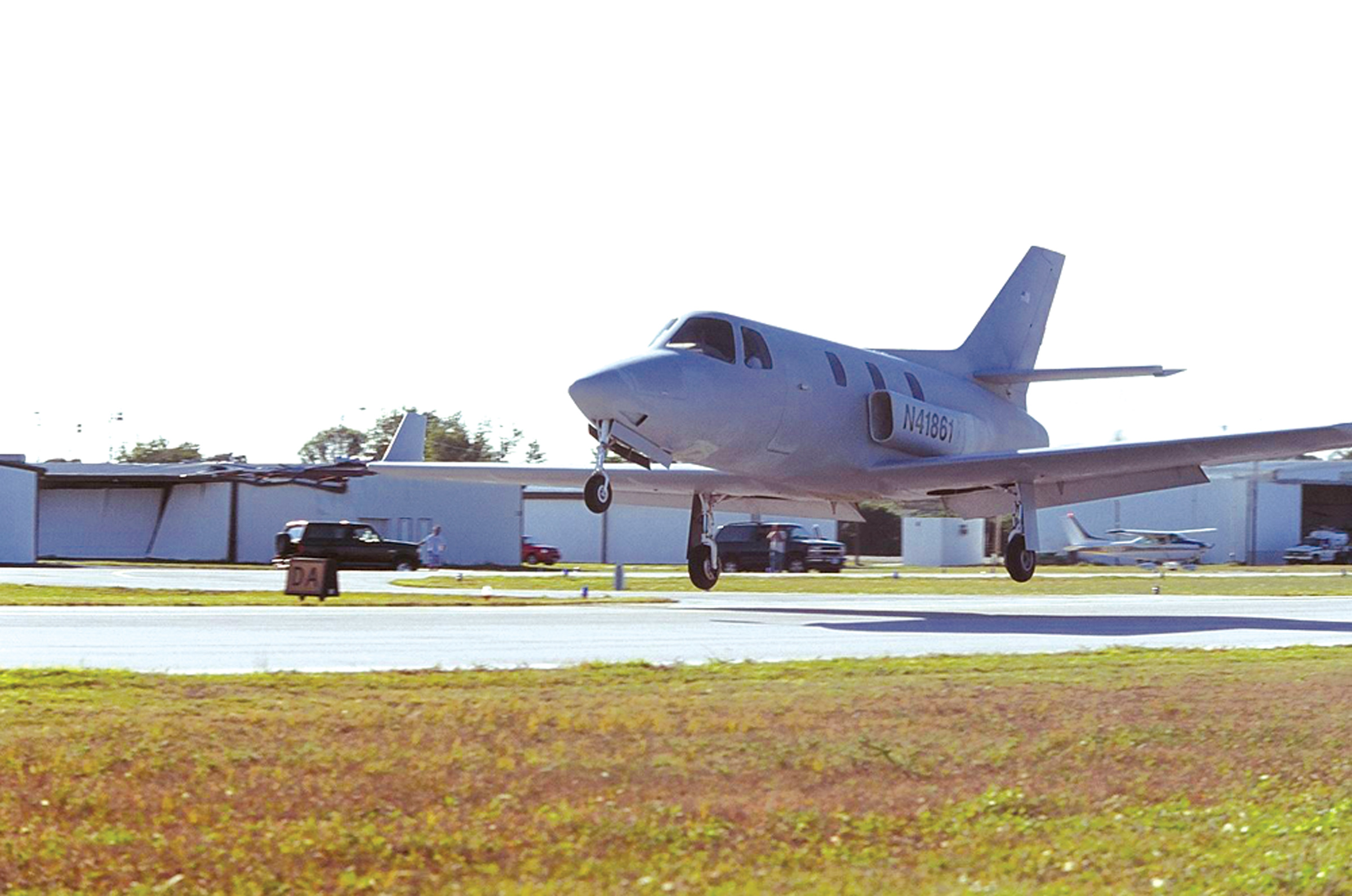By S. Clayton Moore

Ron Lueck pilots the new Comp Air Jet to a successful touchdown at Merritt Island Airport on February 1, following successful flight tests in Titusville, Fla.
After more than a decade in the composite experimental aircraft business, Aerocomp, Inc. of Merritt Island, Fla., is stepping up to the jet market. The company has just celebrated a significant milestone in the development of its new single-engine Comp Air Jet after beginning its exhaustive flight testing at Titusville Airport.
Located a few miles south of Kennedy Space Center, the company was started in 1993 by experienced pilot Ron Lueck and partner Steve Young. Lueck and his father were introducing a line of floats for experimental aircraft and as Young was getting pilot training at their airport, they began a business partnership.
“We started with an interest in doing composite aircraft floats for light two and four-place aircraft,” Young said. “As we went to more air shows with our demonstrator aircraft and talked to more and more people about what they wanted out of an airplane, they all seemed to want something more substantial than they were currently flying.”
They started business with the rights to the Merlin, a two-place, tube-and-fabric aircraft, but as time went on, Lueck and Young saw a real need for a durable, four-seat kit plane. Utilizing Lueck’s expertise in composite materials, the plane had to be easy to build, easier to fly and inexpensive to purchase. In short, the aircraft had to be based in simplicity. That insight led to the development of the Comp Air 4.
That basic concept in turn has led to the development of several different iterations of both piston and turbine aircraft including the Comp Air 6, 7, 8 and 10. Sales have been booming for the past decade and have doubled each year for the past five years. There are now more than 30 turbine-powered Comp Air aircraft flying and at least 100 privately-owned, piston-powered planes. About 200 other Comp Air aircraft are currently under construction.
As the two pilots continued to market their aircraft at air shows around the country, they began to see a different demand emerging from the increasingly challenged business aircraft market.
“We were at the air show every day listening to customers for 12 hours a day,” Young explained. “They were all saying, ‘These are great, but I’d like to go up a little. I fly an Aerostar or a T36 or a Kingair, but there’s not enough useful load and it’s really dicey around the pattern.’ More and more people were looking to get out of their twins. They wanted that performance but they also wanted a higher useful load, and for a lot of them, their ultimate dream is to fly a jet.”
At first, they were resistant to the idea, but they began to sympathize with business owners who need interstate travel options but can’t justify the high operating and maintenance costs for a jet.
“We found that most of our customers don’t need a jet with transcontinental abilities,” Young said. “They just need to go from here to Atlanta; it just doesn’t pay to take 45 minutes getting to Orlando and then two hours in security for a 45-minute flight. Getting there and back kills the whole day.”

Staff at Aerocomp’s headquarters ready a remanufactured AI-25 jet engine for use in the company’s new composite kit jet.
To satisfy this new breed of customers, Aerocomp began simultaneously developing a pressurized high-tech turbine aircraft, the Comp Air 12, as well as the new Comp Air Jet. The Comp Air 12, like its predecessors, is an all-composite kit aircraft powered by a 1,400-hp Lycoming T53 engine. It has a range of 2,800 miles and a top speed of 375 knots. Priced at approximately $449,000 before avionics, the Comp Air 12 is a logical extension of Aerocomp’s standard line, which has been growing in size and capabilities for years.
However, the Comp Air Jet much more closely resembles modern corporate jets like the Citation. It seats eight passengers, boasts an impressive 5,900-lb. useful load and has a projected cruising speed of 400 mph. Keeping in mind its customers’ needs, the plane was designed with a 1,000 mile range with the ability to take off and land on strips of 3,500 feet or more.
Young explained that engine selection was crucial to building an affordable aircraft for its customers.
“We decided early on to use a former Soviet bloc engine, the AI-25 high-bypass turbofan jet engine that was in the L39 Albatross, because they were available and they had a good track record and were available at a good price,” he said. “The engine price was what killed a lot of jet program. You start hanging two $650,000 engines on an aircraft and the price goes out of the ballpark.”
That decision has brought the price of the Comp Air Jet down to $399,000, including the engine in kit form with an estimated finished cost of $550,000 to $600,000, a fraction of comparable corporate jets.
“If we can make it work with a reasonable engine that we can buy for $70,000 with a fresh inspection and overhaul, then we can go ahead and fly it,” Young said. “Our fuel economy may not be as good, but our costs of operation will be so much lower because of the overhaul costs of the engine, and initial purchase is so much lower. We can fly this aircraft for around $600 per hour, which makes sense even with only two people in the airplane. That was how the process was driven.”
Although demand has been high, Aerocomp is taking an unusual approach in its deposit and delivery program. While the company plans to begin taking orders soon, they haven’t taken a single deposit yet.
“Basically, we’ve done it a little different this time,” Young said. “We won’t take anybody’s money until we’re done and this aircraft is ready to fly. We wanted to be in full-production before we started selling it. This demonstrator is actually made from the molds that our customers’ aircraft will be made from. Rather than building prototypes and taking money up front like everyone else in this market has done, this is really what you’re going to get.”
Aerocomp currently plans to begin with $75,000 delivery reservations. Deliveries will happen every six weeks for the first six months. Like its other aircraft, Aerocomp’s jet is classified under the FAA’s experimental aircraft rules. Although many owners seek assistance from shops such as Aerocomp’s builder assistance partners like Skybuild, they are required to be present and work with technicians through the entire build process. This ensures the owners meet the FAA’s “51-percent rule,” allowing him to be listed as the manufacturer and work on the aircraft.

Staff at Aerocomp’s headquarters ready a remanufactured AI-25 jet engine for use in the company’s new composite kit jet.
“They have to be there when the plane is built,” Young said. “Basically, it doesn’t do us any good to have an unknowledgeable owner because he’s not a safe owner. We don’t care if he’s not going to do the maintenance, but we want him to understand every inspection performed on the airplane. It’s a process of demystifying the airplane for some owners.”
Ron Lueck put the aircraft through its paces during testing earlier this year at Titusville’s unpredictably windy location and was pleased with the jet’s performance.
“It flies!” Lueck said, after emerging from the aircraft’s maiden flight. “My first impressions were very positive and encouraging. Pitch, roll and yaw control were positive and harmonious, making the big plane easy to handle.”
Work continues on the test-flight program and systems installation as Aerocomp works hard to build the best possible aircraft for its customers. Young and Lueck now have 20 employees working in three hangars totaling 24,000 square feet and have plans to expand to 50 employees in a new 100,000-square-foot facility as their new aircraft take off.
“The reality is that a lot of these people are not fighter pilots,” Young said of their customers. “They’re well-off business people who have owned two or three airplanes and they’re just trying to get from point A to point B in a timely fashion. We just want to build a nice, safe aircraft for them.”
For more information about Aerocomp’s products, including the new Comp Air Jet, call 312-453-6641 or visit [http://www.aerocompinc.com].











